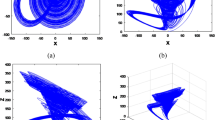Abstract
Characteristic features of security management for the cyber-physical system (CPS) have been distinguished. Existing approaches to the CPS security management have been systematized and their limited use in the CPS has been shown. An homeostatic approach to security management based on the CPS functional stability preservation has been proposed. A structure of homeostat for controlling the CPS has been described. A homeostatic model has been developed using logical predicates. The criteria for assessing the functional stability of the CPS have been proposed. The results of experimental studies showing the applicability of the proposed criteria have been presented.
Similar content being viewed by others
References
Zegzhda, D.P., Sustainability as a criterion for information security in cyber-physical systems, Autom. Control Comput. Sci., 2016, no. 8, pp. 813–819.
Dukhvalov, A., IIoT–Industrial Internet of Threats? http://go-url.ru/iez3.
Hackmageddon: Information security timelines and statistics. http://www.hackmageddon.com/.
Vasil'ev, Yu.S., Zegzhda, P.D., and Zegzhda, D.P., Ensuring the safety of automated control systems for technological processes at hydropower facilities, Izv. Ross. Akad. Nauk, Sektsiya Energet., 2016, no. 3.
Zegzhda, D.P., Stability as a criterion of information security of computer systems, Probl. Inf. Bezop., Komp’yut. Sist., 2016, no. 2, pp. 12–20.
Zegzhda, D.P., Problems of cyberstability of digital production, Sbornik tezisov 26-i nauchno-tekhnicheskoi konferentsii “Metody i tekhnicheskie sredstva obespecheniya bezopasnosti informatsii” (Problems of Cyberstability of Digital Production. Proc. 26th Scientific and Technical Conference Methods and Technical Means of Information Security), St. Petersburg, 2017, pp. 85–86.
Zegzhda, P.D. and Zegzhda, D.P., Dynamic protection methodology, MMM-ACNS'2005 Workshop Committee (MABIT-05)), Moscow, 2005, pp. 216–229.
Zegzhda, P.D., Approaches to assessing the safety of cyberphysical systems, Materialy konferentsii RusKripto 2017 (Proc. Conf. RusKripto 2017), 2017. http://www.ruscrypto.ru/resource/summary/rc2017/09_zagzhda.pdf.
Zegzhda, P.D., Poltavtseva, M.A., and Lavrova, D.S., Systematization of cyberphysical systems and evaluation of their safety, Probl. Inf. Bezop., Komp’yut. Sist., 2017, no. 2, pp. 127–138.
Butenko, D.V., Albegov, E.V., and Ternovoi, I.S., A neural network based on homeostatic mechanisms of control, Inzh. Vestn. Dona, 2013, no. 3. http://www.ivdon.ru/magazine/archive/n3y2013/1761.
Kureichik, V.V. and Kureichik, V.M., Use of homeostatic principles in management in intellectual systems, Izv. YuFU, Tekh. Nauki, 2002, no. 3. http://cyberleninka.ru/article/n/ispolzovanie-printsipov-gomeostatiki-priupravlenii-v-intellektualnyh-sistemah.
Rokhlov, V.S. and Trofimov, S.B., History of the development of the doctrine of homeostasis, Obshch. Biol., 2015, no. 22 (797), 2015.
Gorskii, Yu.M., Stepanov, A.M., and Teslinov, A.G., Gomeostatika: Garmoniya v igre protivorechii (Homeostatics: Harmony in the Game of Contradictions), Irkutsk: Reprotsentr A1, 2008.
Teslinov, A.G., Razvitie sistem upravleniya: Metodologiya i kontseptual’nye struktury (Development of Management Systems: Methodology and Conceptual Structures), Moscow: Globus, 1998.
Gerostathopoulos, I., Skoda, D., Plasil, F., Bures, T., and Knauss, A., Architectural Homeostasis in Self-Adaptive Software-Intensive Cyber-Physical Systems, ECSA, 2016.
Gerostathopoulos, I., Bures, T., Hnetynka, P., Keznikl, J., Kit, M., Plasil, F., and Plouzeau, N., Self-adaptation in software-intensive cyber-physical systems: From system goals to architecture configurations, J. Syst. Software, 2016, vol. 122, pp. 378–397.
Baranov, A.P., Application of a posteriori protection in the system of tax authorities, Materialy XI Ezhegodnoi Vserossiiskoi Konferentsii “Obespechenie informatsionnoi bezopasnosti. Regional’nye aspekty. InfoBEREG-2012" (Proc. XI Annual All-Russian Conference Ensuring Information Security: Regional Aspects. InfoBREEG-2012), Sochi, 2012.
Karpenko, A.P., Semenikhin, A.S., and Mitina, E.V., Population methods for approximating the Pareto set in the problem of multicriteria optimization. Review, Nauka Obraz. MGTU im. N. E. Baumana, 2012, no. 4. http://www.technomag.edu.ru/doc/363023.html.
Larionov, I.P. and Khorev, P.B., Pareto-optimization in the field of decision-making when designing a comprehensive enterprise protection system, Naukovedenie, 2016, vol. 8, no. 2. http://naukovedenie.ru/PDF/118TVN216.pdf.
Lavrova, D.S., An approach to developing the SIEM system for the Internet of Things, Autom. Control Comput. Sci., 2016, no. 8, pp. 673–681.
Lavrova, D. and Pechenkin, A., Applying correlation and regression analysis methods for security incidents detection in the Internet of Things, Int. J. Commun. Networks Inf. Secur., 2015, vol. 7, no. 3, pp. 131–137.
Kuptsov, P.V., Calculation of Lyapunov exponents for distributed systems: Advantages and disadvantages of various numerical methods, Izv. Vuzov, PND, 2010, no. 5. http://cyberleninka.ru/article/n/vychislenie-pokazateley-lyapunova-dlya-raspredelyonnyh-sistem-preimuschestva-i-nedostatki-razlichnyh-chislennyh-metodov.
Lavrova, D.S., The approach to the development of the SIEM system for the Internet Things, Probl. Inf. Bezop., Komp’yut. Sist., 2016, no. 2, pp. 50–60.
Zegzhda, D.P., Principles and methods of creating secure information processing systems, Doctoral (Eng.) Dissertation, St. Petersburg, 2002.
Author information
Authors and Affiliations
Corresponding author
Additional information
Original Russian Text © D.P. Zegzhda, E.Yu. Pavlenko, 2017, published in Problemy Informatsionnoi Bezopasnosti, Komp’yuternye Sistemy.
About this article
Cite this article
Zegzhda, D.P., Pavlenko, E.Y. Cyber-physical system homeostatic security management. Aut. Control Comp. Sci. 51, 805–816 (2017). https://doi.org/10.3103/S0146411617080260
Received:
Published:
Issue Date:
DOI: https://doi.org/10.3103/S0146411617080260




